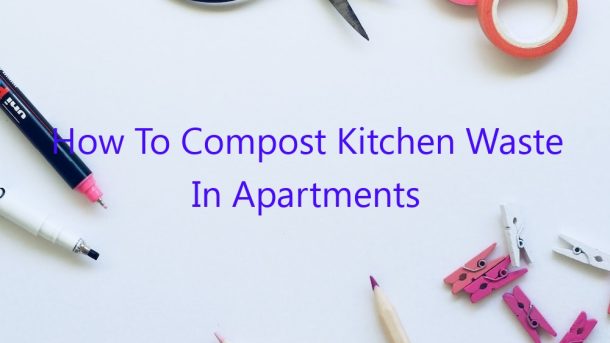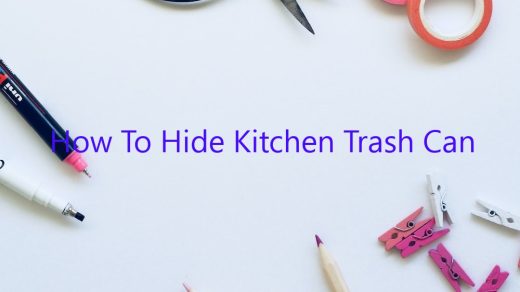When it comes to composting, apartments can be a little tricky. You might not have the space for a compost bin, or you might not be able to access a garden to dump your compost. But don’t worry, there are plenty of ways to compost in an apartment!
One option is to use a vermicomposting bin. This is a bin that uses worms to break down the compost. You can buy a bin, or make your own. If you choose to make your own, you’ll need a plastic bin with a tight-fitting lid, some bedding material (straw, shredded paper, or leaves work well), and a handful of red wiggler worms. The worms will eat the organic material in the bin and turn it into compost.
Another option for composting in an apartment is to use a bucket composting system. This is a simple system where you use a bucket to store your compost, and then dump it into a larger container or garden bed when it’s full. You can buy a composting bucket, or make your own. To make your own, you’ll need a bucket with a tight-fitting lid, some soil, and a handful of worms. The worms will eat the organic material in the bucket and turn it into compost.
If you don’t want to use a bin or a bucket, you can also compost in your kitchen. You can use a composting pail, which is a small container that you can keep on your countertop. The pail has a charcoal filter to keep the smell down, and it’s easy to use. You just add your food waste to the pail, and then dump it into your compost bin or garden when it’s full.
No matter what method you choose, there are a few things you’ll need to remember when composting in an apartment. First, make sure you have a place to dump your compost. If you’re using a bin or a bucket, you’ll need to have a garden or another container to dump it into. If you’re composting in your kitchen, you’ll need to have a compost bin to store the compost in. Second, make sure you’re composting the right things. Only add organic material to your compost bin. This includes food waste, garden waste, leaves, and straw. Do not add plastics, metals, or other non-organic materials. Third, make sure you’re adding enough water. Composting needs water to work properly, so make sure you’re adding enough to keep the compost moist. Fourth, make sure you’re turning your compost. This will help it break down faster. And finally, be patient! Composting takes time, so don’t expect to see results overnight.
Contents [hide]
How can I compost my apartment without it smelling?
Is composting your apartment smelling up the place? Fear not! There are a few ways to compost without it smelling up your place.
One way to compost without it smelling is to use a Bokashi bin. Bokashi bins are special bins that use a bran and molasses mix to ferment food scraps. The fermentation process eliminates any smell.
Another way to compost without it smelling is to use a vermicomposting bin. With a vermicomposting bin, you use red wriggler worms to eat and break down your food scraps. The worms will eat the food scraps and break them down, eliminating any smell.
If you don’t have a Bokashi bin or a vermicomposting bin, you can still compost without it smelling. You can use a compost bin with a lid to keep the smell in. You can also compost in a sealed container, like a garbage bag. If you compost in a sealed container, make sure to poke a few holes in the bag so that the compost can breathe.
No matter what method of composting you use, make sure to mix in some soil or compost every time you add food scraps. This will help to absorb any smell and will also help to break down the food scraps.
composting is a great way to recycle food scraps and reduce your waste. With a little bit of effort, you can compost without it smelling up your place.
Is it worth composting in an apartment?
In a world where sustainability is becoming more and more important, apartment dwellers may be wondering if composting is worth the effort. The answer is yes, it absolutely is! Composting is a great way to reduce the amount of waste you produce and, in turn, help preserve our planet.
There are a few things to keep in mind if you want to start composting in your apartment. The first is that you’ll need a container to collect your compost in. This can be anything from a large container or bucket to an old plastic bin. The second is that you’ll need to gather some materials to start composting. This includes things like fruit and vegetable scraps, leaves, grass clippings, and shredded paper.
Once you have your container and materials, it’s time to start composting! The process is simple. Just add your scraps to the container and let it sit. Be sure to mix it up every once in a while to help the composting process along. The compost will start to form after a few weeks and, once it’s ready, you can use it to fertilize your plants or garden.
Composting is a great way to reduce your environmental impact and is definitely worth the effort if you live in an apartment. Just be sure to gather a container and some materials and get started!
How do I get compost in my apartment?
Composting is a great way to recycle organic matter and create nutrient-rich soil for your plants. It can be done in any space, even an apartment. Here’s how to get started:
Choose the right container. You’ll need a container with drainage holes that can hold at least 5 gallons. A plastic storage container or a metal trash can with a tight-fitting lid both work well.
Add composting materials. The best materials for composting are organic matter such as fruit and vegetable scraps, coffee grounds, eggshells, and plant clippings.
Add water. The composting process creates moisture, so you don’t need to add water unless the material is very dry.
Stir the contents occasionally. This helps the composting process and prevents the material from becoming matted.
Check the moisture level. If the material is too wet, add more dry material. If it’s too dry, add water.
When the compost is ready, it will be dark and crumbly. You can use it in your garden or give it to your neighbor.
Composting is a great way to recycle organic matter and create nutrient-rich soil for your plants. It can be done in any space, even an apartment. Here’s how to get started:
Choose the right container. You’ll need a container with drainage holes that can hold at least 5 gallons. A plastic storage container or a metal trash can with a tight-fitting lid both work well.
Add composting materials. The best materials for composting are organic matter such as fruit and vegetable scraps, coffee grounds, eggshells, and plant clippings.
Add water. The composting process creates moisture, so you don’t need to add water unless the material is very dry.
Stir the contents occasionally. This helps the composting process and prevents the material from becoming matted.
Check the moisture level. If the material is too wet, add more dry material. If it’s too dry, add water.
When the compost is ready, it will be dark and crumbly. You can use it in your garden or give it to your neighbor.
How do you compost kitchen scraps indoors?
Composting is a great way to reduce your environmental impact and get free fertilizer for your plants. You can compost kitchen scraps indoors in a container or bin.
The first step is to find a container or bin that is the right size for your needs. You’ll want to choose a container that is at least 12 inches wide and 12 inches deep. You can use a plastic container or a metal container. Make sure the container has a tight-fitting lid.
Next, you’ll need to gather some materials to use as composting ingredients. You’ll need some organic matter like leaves, grass clippings, or straw. You’ll also need some nitrogen-rich materials like kitchen scraps, manure, or coffee grounds.
The next step is to assemble your composting bin. Start by putting a layer of organic matter in the bottom of the container. Next, add a layer of nitrogen-rich materials. Repeat these layers until you reach the top of the container.
Then, it’s time to start composting! Add a small amount of water to the composting bin and stir the ingredients together. Every few weeks, add another layer of organic matter and nitrogen-rich materials.
Your compost should be ready to use in a few months.
How do apartments deal with food waste?
Food waste is a major issue when it comes to apartment living. Not only is it wasteful to produce, but it can also create some major problems if not dealt with properly. Here’s a look at how apartments deal with food waste.
Food waste is produced when food is thrown away rather than eaten. This can happen for a variety of reasons, such as spoiled food, leftovers that are never eaten, or food that is purchased but never used. In apartments, food waste can create some serious problems.
The first issue is that food waste can produce a lot of unpleasant smells. This can be a major problem when there are a lot of people living in close quarters. The smell can also attract pests, such as cockroaches and rats.
Another issue is that food waste can create a lot of waste. This can be a problem when there is no room to store it. In apartments, food waste often has to be disposed of in the trash, which can create a lot of extra work.
There are a few ways to deal with food waste in apartments. One is to compost it. This can be done by using a compost bin or by using a worm bin. Composting can help to reduce the amount of waste that is produced and also helps to fertilize plants.
Another option is to freeze the food waste. This can help to reduce the smell and keep pests away. It can also help to prevent the food from decomposing, which can create more waste.
Finally, the food waste can be disposed of in the trash. This is the least preferable option, but it is sometimes necessary.
Food waste is a major issue for apartments. There are a few ways to deal with it, including composting, freezing, and disposing of it in the trash.
Can you compost indoors without worms?
Yes, you can compost indoors without worms, but it’s not as efficient as using worms. Composting is the process of breaking down organic matter into a nutrient-rich soil amendment. You can use worms to speed up the process, but it’s not essential.
There are several ways to compost indoors without worms. The simplest is to use a compost bin. You can buy a compost bin or make one yourself out of a plastic storage container. Another option is to use a vermicomposter, which is a bin that uses worms to break down the organic matter.
If you choose to compost without worms, you’ll need to add more organic matter to the compost pile to compensate for the worms’ absence. You can add green waste, such as vegetable scraps, fruit peels, and coffee grounds, and brown waste, such as dead leaves, straw, and wood shavings. Be sure to mix the ingredients together well to create a balanced compost pile.
The composting process will take a little longer when you’re not using worms, but it will eventually produce a rich soil amendment. Composting is a simple way to recycle organic waste and improve the quality of your soil.
How do you compost an apartment without worms?
Composting is a process of breaking down organic matter into a soil-like substance. This can be done using worms in a vermicomposting bin, or without worms in a passive composting system.
In an apartment without worms, you can compost using a passive composting system. A passive composting system is a simple way to compost using materials you already have in your home. There are a few different ways to set up a passive composting system, but all of them involve creating a bin with a lid and adding your composting materials to it.
One way to set up a passive composting system is to use a plastic storage container with a lid. Punch a few holes in the bottom of the container for drainage, and add a layer of soil or compost to the bottom. Add your composting materials to the container, and then add another layer of soil or compost on top. The composting materials will break down over time, and the soil or compost on top will help to keep the composting materials moist.
Another way to set up a passive composting system is to use a large pot with a lid. Add a layer of soil or compost to the bottom of the pot, and then add your composting materials. Add another layer of soil or compost on top, and then put the lid on the pot. The composting materials will break down over time, and the soil or compost on top will help to keep the composting materials moist.
A third way to set up a passive composting system is to use a large garbage can with a lid. Add a layer of soil or compost to the bottom of the can, and then add your composting materials. Add another layer of soil or compost on top, and then put the lid on the can. The composting materials will break down over time, and the soil or compost on top will help to keep the composting materials moist.
The best way to set up a passive composting system is to use a combination of these methods. Choose a container that is large enough to hold your composting materials, and add a layer of soil or compost to the bottom of the container. Add your composting materials to the container, and then add another layer of soil or compost on top. Make sure to add a lid to the container to keep the composting materials moist.
Composting is a great way to recycle organic materials, and a passive composting system is a simple way to compost without worms.




